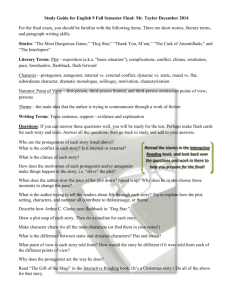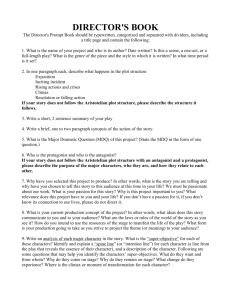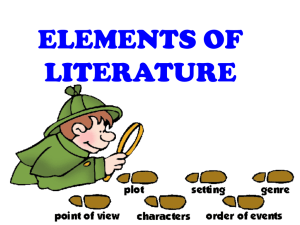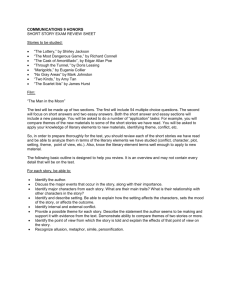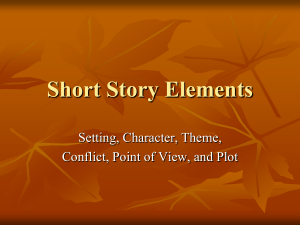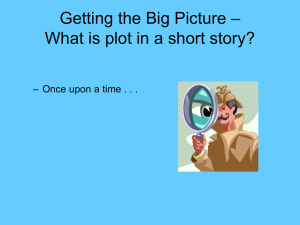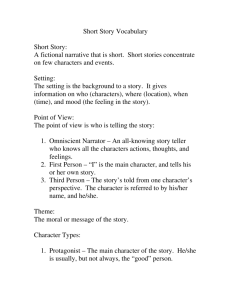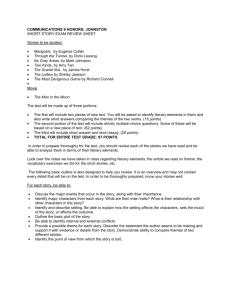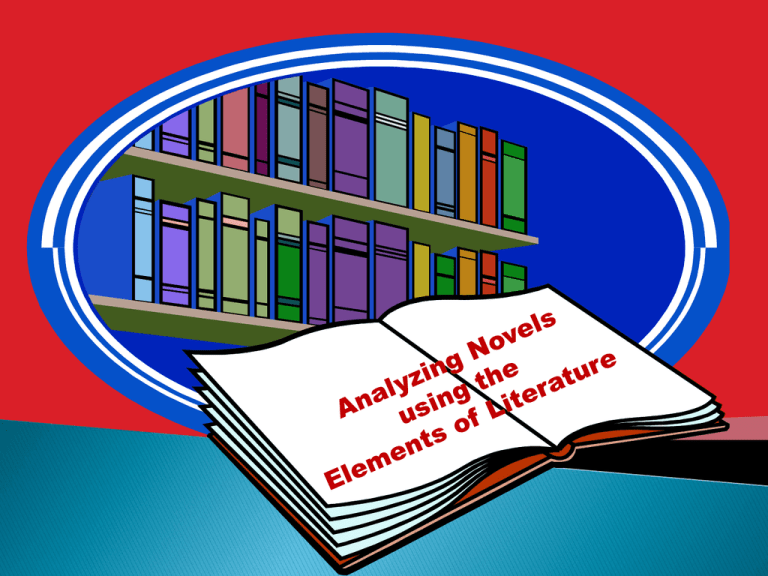
SETTING
HOW DOES IT IMPACT THE
CHARACTERS AND CONFLICT?
Points to Ponder:
When is SETTING important to
the story?
When doesn’t SETTING impact
the plot?
Think of a book where SETTING
(Place and Time) were crucial to
the plot.
How do the characters beliefs,
values, actions and reactions
reflect the SETTING (Time and
Place)?
SETTING = PLACE and TIME
How are characters developed?
The author reveals and develops
characters through:
What the narrator says about the
character.
What the character says.
How the character acts and
reacts to situations.
What others say about the
character.
How others act/react toward the
character.
Discuss how and why characters’
names are important.
PLOT
Climax
Rising Action
(Turning Point)
The Climax is decision time for the Protagonist,
the point where all of the tension reaches the
boiling point. This is when the reader knows if the
Protagonist reaches his/her goal or not.
(Complications)
Each Complication deepens
the Protagonist’s struggle
with the Antagonist .
Each Complication stems
from the one before it and
leads into the next situation.
Falling Action (Resolution)
(The conflict unravels)
The Falling Action clarifies the
events that occur after the Climax.
The Inciting Moment hooks the
Protagonist and Antagonist, and
propels them from the
Rising Action through to the
Resolution.
The Exposition or Background provides
basic information that the author develops
as the story about the Protagonist,
Antagonist, plot/conflict and setting unfolds.
Denouement
(Conclusion)
The Denouement ties together any
loose ends from the plot, the subplots
and with the characters.
Person vs. Person
Person vs. Self
Man vs. Society
Secondprinting.blogspot.com
hbvk.com
pollsb.com
Person vs. Nature
Person vs. Supernatural
Person vs. Machine
pollsb.com
yourecoteam.com
Pongalong.com
What Kind of World Does
the Author Create?
A story reflects the qualities that make the setting unique. The characters
and events create a word picture of that specific time and place by
developing these qualities. The story serves as a vehicle that reveals the
social, political, ethical and religious standards of that period. The
characters, as well as their actions and reactions, are reflective of that
particular period.
Values
?
Expected Behaviors?
The Theme that the author develops is the point that he/she makes about
people, or their beliefs and/or their actions, or any combination of these
factors. What makes a Theme universal is its ability to transcend Time and
Place. A contemporary author, for example, could be making the same
point about war as Homer did in The Aeneid. Unlike the moral of a fable,
the Theme is never directly stated, but is implied. The reader’s job is to
verbalize this message.
Choices in life
Coming of age
Conflict of cultures and
values
The individual and society
Life and loss
Nature of evil
The power and pain of love
Triumph and defeat
The uses and abuses of power
Loss of innocence
Examples of Theme:
•The lack of communication can lead to tragedy.
•In war, everyone loses.
•If he chooses, man can overcome any hurdle or hardship.
•A person must stay true to him/herself.
Ribbons
Handkerchief
Violin
Vanity (Animal Farm)
Beauty; defiance (Night)
Geese
Fidelity (Othello)
Food
Gold Candlesticks
Freedom (One Flew Over the
Cuckoo’s Nest)
Temptation (The Odyssey)
Materialism (The Crucible)
Indifferent bitter satirical happy insistent
bold Apprehensive
silly
incredulous
nostalgic
terrified skeptical sympathetic candid
admirable
Provocative Harsh
joyful despairing joking
sorrowful
Demanding arrogant
melodramatic upset excited
bored subdued
The author specifically chooses words and sentence structures to
convey his/her Attitude about the characters, their beliefs and their
actions and reactions. The way he/she has the characters talk and act
are meant to show their attitudes about themselves, about those
around them and about the lives that they lead.
Allegory: characters and actions stand
for something in history, religion, art,
etc. Has a real and a symbolic meaning.
Alliteration: the repetition of
beginning sounds.
Allusion: a reference to a person, place
or thing in literature, art, history, etc.
Example; References to Dracula and
Merlin in To Kill a Mockingbird.
Epilogue: a short narrative at the end
of a story that ties up any loose ends
for the characters and in the plot.
Flashback: reveals details from an
earlier time in the character’s life.
Foreshadowing: hints about future
events.
Hyperbole: an exaggeration or
overstatement. Example: It was hot
enough to fry an egg on the sidewalk.
Imagery: words/phrases that stir up
the five senses: sight, taste, touch,
smell, and hearing.
Irony: what is said or what is happening
is different from what is meant or what
should be occurring.
Metaphor: a direct comparison
between two unlike things. Example:
The sun is an orange.
Mood: the author’s emotional attitude
toward the characters and events (see
TONE slide).
Oxymoron: using a contradictory
adjective to describe a noun; i.e. jumbo
shrimp.
Paradox: contradictory on one level,
but reveals a deeper truth.
Point of View: the beliefs and attitude
of the narrator of the story.
Simile: the comparison of two unlike
things using either like or as. Example:
The sun is like an orange.
Syntax: the way words are put together
to form phrases and sentences.
PowerPoint: Elements of Literature (10 slides):
Copyright © 2011/2013 Constance D. Casserly All rights reserved by author.
Copying for more than one teacher, classroom, department, school, or school system is prohibited.

